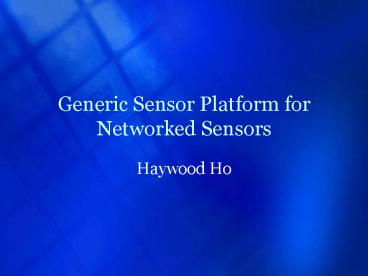Generic Sensor Platform for Networked Sensors
1 / 17
Title:
Generic Sensor Platform for Networked Sensors
Description:
Developing generic sensor platform jointly with civil ... A/D converter. Network reprogramming. Battery. Radio (916 MHz) EPROM, Program Memory, Data Memory ... –
Number of Views:32
Avg rating:3.0/5.0
Title: Generic Sensor Platform for Networked Sensors
1
Generic Sensor Platform for Networked Sensors
- Haywood Ho
2
Introduction
- Goals for summer
- Longer-term goals
- Developing generic sensor platform jointly with
civil engineering students to write applications
3
Introduction
- Smart Dust
- TinyOS
- Generic Sensor
4
Smart Dust
- MICA
- ATMEL ATMEGA103 4MHz processor
- A/D converter
- Network reprogramming
- Battery
- Radio (916 MHz)
- EPROM, Program Memory, Data Memory
5
(No Transcript)
6
Overview of TinyOS
- Tiny, Microthreaded, Operating System
- Designed specifically to meet constraints of
sensor networks - Robust operation
- Low computational power
- Low power
- Little memory
7
Tiny OS The Software
- Component based model
- Abstracts hardware specifics from application
programmer - Capable of maintaining high levels of concurrency
- Services Provided Include
- RF messaging protocols.
- Periodic Timer Events.
- Asynchronous access to UART data transfers.
- Mechanism for Static, Persistent Storage.
- Complete applications fit in 4KB of ROM and 256B
RAM
8
Generic Sensor Platform
- Currently, three types of messages
- A network discovery packet
- Data packets
- Generic Sensor command packets
9
Generic Sensor Overview
- Matlab front-end to allow application developers
to control motes (mostly developed by Kamin
Whitehouse, graduate student in TinyOS group) - Integrates many pre-existing applications to
allow motes to be programmed with Matlab instead
of TinyOS code (abstraction) - No need for network reprogramming
- Library of data analysis tools in Matlab
10
Architecture
11
Network Discovery Radio Cells
12
Network Discovery
13
Network Discovery
- Simple routing algorithm to form routing tree
- No cycles
- Too many rebroadcasts
- Unstable tree
- Can pick bad links
14
OSCOPE Data Packets
- Routed back to the base station using route from
network discovery - Data can then be captured and visualized in
real-time in the Matlab environment
15
Demonstration
16
Conclusions
- Generic Sensor platform allows faster deployment
of sensor networks - Allows application programmers to abstract away
from lower-level details of TinyOS
17
Further Work
- Log and Sleep
- Simultaneous sensing from different data channels
- Time synchronization issues between motes
- Robustness
- Alternative ad-hoc routing alogirthms































